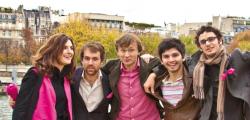
Magda Forsberg by Götz A. Primke from Wikimedia Commons
Top 8 Interesting facts about Magdalena Forsberg
A former cross-country skier and biathlete from Sweden, Magdalena “Magda” Forsberg (née Wallin) was born on July 25, 1967. She won the Biathlon World Cup six times in a row and was the dominant female biathlete from 1997 to 2002 when she announced her retirement. In addition, she has won the women’s biathlon World Cup the most times, six times, and has two bronze medals from the Olympics.
In the modern biathlon, competitors pull a. 22-calibre rifle off their backs, point it at a target, and fire during periodic breaks in the normal cross-country ski race. Time is lost when targets are missed, and competitors occasionally have to ski a 150-meter penalty lap. You can already imagine how challenging this sport is but Magdalena has managed to push the envelope, read the top 8 interesting facts about her below.
1. From 1988 until 1996, Forsberg competed in cross-country skiing

Superstars by Holger.Ellgaard from Wikimedia Commons
From 1988 until 1996, Forsberg took part in World Cup competitions as a cross-country skier. In the 4 5 km relay, she placed seventh, and in the 15 km event, she placed 26th, she had her greatest performance at the Winter Olympics in Albertville in 1992.
2. She skied for the Swedish national team for several years
She spent a number of years competing for the Swedish national team, and in 1987, she took home a bronze medal with the relay team representing that nation. Due to an illness, Forsberg was unable to compete in cross-country skiing in the 1988 Olympics. When she finally competed in 1992, however, she performed miserably, placing no higher than twenty-sixth in any given event.
3. From 1997 through 2002, Forsberg won the Biathlon World Cup six times in a row
Forsberg participated from 1993 to 2002, winning six consecutive World Cup biathlon competitions for the overall title. Moreover, she finished third five times, finished second once, and won six gold medals at the World Championships. Forsberg won two bronze medals in the 2002 Winter Olympic Games. More than any other female biathlete to date, she managed to win 42 individual Biathlon World Cups throughout her career.
4. She was unable to compete in the 1994 summer Olympics due to an injury
Due to an illness, Forsberg was unable to participate in the cross-country skiing competition at the 1988 Olympics. When she finally competed in 1992, she performed poorly, placing no higher than twenty-sixth in any individual event. Forsberg gave up competitive cross-country skiing after suffering an Achilles tendon injury and needing surgery, which prevented her from competing in the 1994 Olympics.
5. Her father taught her how to handle a gun
At about the same time, Forsberg started competing in biathlon, a sport that combines shooting with cross-country skiing. She was already proficient with a firearm; she had picked up the ability from her father, Jan, who used to accompany Forsberg when he went moose hunting when she was a young child.
Forsberg asserts that she merely wanted to attempt biathlon for fun—and not to win prizes—but in 1994, she began competing in biathlon competitions. To her own surprise, Forsberg was fifth in the overall World Cup points standings and had won one 7.5-kilometre sprint race before the end of her rookie 1994–1995 season.
6. Her Fiancee inspired her to try biathlon
Forsberg’s fiancé, Henrik Forsberg, who started out as a cross-country skier before switching to biathlon, served as some of her inspiration for trying the sport. (The two were wed in 1996; before her marriage to Henrik, Forsberg competed as Magdalena Wallin.)
Although Forsberg downplays the discrepancy in their records, attributing it to Henrik’s numerous injuries, Henrik’s lone victory in his career came in a cross-country race of thirty kilometres in 1991. As a result, he hasn’t demonstrated his abilities.
7. Forsberg’s first World Cup victories came in 1997
When Forsberg won the overall and pursuit point standings in 1997, she claimed her first World Cup victories. Her Swedish supporters had high expectations for her to medal at the 1998 Nagano Olympics, but it was not to be. Forsberg’s nerves were impacted by the pressure, which impaired her shooting.
Forsberg placed fourteenth in the individual-start competition and seventeenth in the sprint as part of the Swedish team, which placed tenth overall in the relay. Forsberg, though, excelled once more that year on the World Cup circuit. She was runner-up in two other specialities and the overall competition while successfully defending her title in the pursuit event.
8. She retired at 34
Forsberg, who was 34 when the Olympics were held in Salt Lake City, declared before the Games that she would stop competing at the end of the following season. Even though she had already won eight of the twenty-two World Cup races that season and had swept all of the championships for the second year in a row, she still managed to finish first.
In the last World Cup race she would ever compete in, Forsberg’s last race was emotional as she said “You have to stop one day. It was a perfect place to end my career. But I felt sad in the morning and tears came into my eyes when I dressed before the race.”

 English
English








